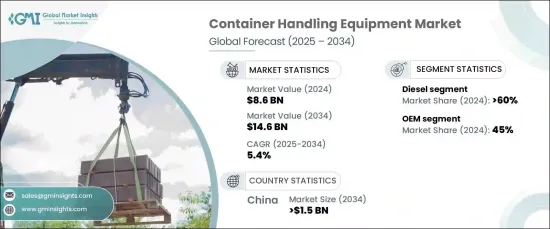PUBLISHER: Global Market Insights Inc. | PRODUCT CODE: 1664873

PUBLISHER: Global Market Insights Inc. | PRODUCT CODE: 1664873
Container Handling Equipment Market Opportunity, Growth Drivers, Industry Trend Analysis, and Forecast 2025 - 2034
The Global Container Handling Equipment Market was valued at USD 8.6 billion in 2024 and is expected to grow at a robust CAGR of 5.4% from 2025 to 2034. This growth is driven by the increasing demand for efficient container handling solutions, fueled by rising international trade and the growing preference for containerized cargo. As global supply chains become more complex, the adoption of advanced systems such as cranes, stackers, and automated technologies is rapidly increasing. Investments in port expansions and infrastructure upgrades are further accelerating the need for state-of-the-art equipment to meet the evolving demands of modern logistics.

The market is segmented by propulsion into diesel, electric, and hybrid systems. Diesel-powered equipment held a dominant 60% share in 2024 and is projected to reach USD 6 billion by 2034. Diesel continues to be a popular choice due to its reliability, well-established infrastructure, and cost-effectiveness. It delivers high power output, making it ideal for heavy-duty operations, especially in environments with limited electric infrastructure. The versatility and dependability of diesel-powered systems ensure they will maintain their lead, particularly in large-scale ports and logistics hubs.
| Market Scope | |
|---|---|
| Start Year | 2024 |
| Forecast Year | 2025-2034 |
| Start Value | $8.6 Billion |
| Forecast Value | $14.6 Billion |
| CAGR | 5.4% |
By capacity, the market is divided into up to 10 tons, 10-50 tons, and 50 tons and above. The up to 10 tons capacity segment is leading the market thanks to its affordability, flexibility, and widespread use across industries. These systems are commonly found in warehouses, manufacturing facilities, and ports handling medium-sized cargo. Their lower cost compared to higher-capacity equipment makes them accessible to a wider range of operators, further strengthening their dominance in the market.
The container handling equipment market in China accounted for 30% of the global share in 2024 and is set to generate USD 1.5 billion by 2034. The country's leadership is attributed to its strong manufacturing capabilities, cost-effective production, and strategic investments in port infrastructure. As a global trade powerhouse, China plays a crucial role in the market, leveraging its large-scale production capacity and competitive pricing to meet the growing demand for container handling equipment.
Table of Contents
Chapter 1 Methodology & Scope
- 1.1 Research design
- 1.1.1 Research approach
- 1.1.2 Data collection methods
- 1.2 Base estimates and calculations
- 1.2.1 Base year calculation
- 1.2.2 Key trends for market estimates
- 1.3 Forecast model
- 1.4 Primary research & validation
- 1.4.1 Primary sources
- 1.4.2 Data mining sources
- 1.5 Market definitions
Chapter 2 Executive Summary
- 2.1 Industry 3600 synopsis, 2021 - 2034
Chapter 3 Industry Insights
- 3.1 Industry ecosystem analysis
- 3.2 Supplier landscape
- 3.2.1 Manufacturers
- 3.2.2 Technology providers
- 3.2.3 Distributors
- 3.2.4 End users
- 3.3 Profit margin analysis
- 3.4 Cost Breakdown of equipment
- 3.5 Technology & innovation landscape
- 3.6 Patent landscape
- 3.7 Use cases
- 3.8 Key news & initiatives
- 3.9 Regulatory landscape
- 3.10 Impact forces
- 3.10.1 Growth drivers
- 3.10.1.1 Growth in global trade and containerized cargo
- 3.10.1.2 Adoption of automation and digital technologies
- 3.10.1.3 Port expansion and infrastructure development
- 3.10.1.4 Technological advancements in equipment
- 3.10.2 Industry pitfalls & challenges
- 3.10.2.1 High initial capital investment
- 3.10.2.2 Operational and maintenance costs
- 3.10.1 Growth drivers
- 3.11 Growth potential analysis
- 3.12 Porter’s analysis
- 3.13 PESTEL analysis
Chapter 4 Competitive Landscape, 2024
- 4.1 Introduction
- 4.2 Company market share analysis
- 4.3 Competitive positioning matrix
- 4.4 Strategic outlook matrix
Chapter 5 Market Estimates & Forecast, By Equipment, 2021 - 2034 ($Bn, Units)
- 5.1 Key trends
- 5.2 Automated Stacking Crane (ASC)
- 5.3 Empty Container Handling Forklift Truck (FLT)
- 5.4 Laden Forklift Truck (FLT)
- 5.5 Mobile Harbor Crane (MHC)
- 5.6 Rail Mounted Gantry (RMG) Crane
- 5.7 Reach Stacker
- 5.8 Rubber Tired Gantry (RTG) Crane
- 5.9 Ship to Shore (STS) Crane
- 5.10 Others
Chapter 6 Market Estimates & Forecast, By Application, 2021 - 2034 ($Bn, Units)
- 6.1 Key trends
- 6.2 Port terminals
- 6.3 Railway terminals
- 6.4 Inland Container Depots (ICDs)
- 6.5 Logistics Hubs
Chapter 7 Market Estimates & Forecast, By Propulsion, 2021 - 2034 ($Bn, Units)
- 7.1 Key trends
- 7.2 Diesel
- 7.3 Electric
- 7.4 Hybrid
Chapter 8 Market Estimates & Forecast, By Capacity, 2021 - 2034 ($Bn, Units)
- 8.1 Key trends
- 8.2 Up to 10 tons
- 8.3 10-50 tons
- 8.4 50 tons and above
Chapter 9 Market Estimates & Forecast, By Region, 2021 - 2034 ($Bn, Units)
- 9.1 Key trends
- 9.2 North America
- 9.2.1 U.S.
- 9.2.2 Canada
- 9.3 Europe
- 9.3.1 UK
- 9.3.2 Germany
- 9.3.3 France
- 9.3.4 Spain
- 9.3.5 Italy
- 9.3.6 Russia
- 9.3.7 Nordics
- 9.4 Asia Pacific
- 9.4.1 China
- 9.4.2 India
- 9.4.3 Japan
- 9.4.4 South Korea
- 9.4.5 ANZ
- 9.4.6 Southeast Asia
- 9.5 Latin America
- 9.5.1 Brazil
- 9.5.2 Mexico
- 9.5.3 Argentina
- 9.6 MEA
- 9.6.1 UAE
- 9.6.2 South Africa
- 9.6.3 Saudi Arabia
Chapter 10 Company Profiles
- 10.1 Konecranes
- 10.2 Cargotec
- 10.3 Liebherr Group
- 10.4 ZPMC (Shanghai Zhenhua Heavy Industries Company)
- 10.5 Terex
- 10.6 Doosan Heavy Industries & Construction
- 10.7 Hyster-Yale Materials Handling
- 10.8 Toyota Industries
- 10.9 Mitsubishi Heavy Industries
- 10.10 SANY Group
- 10.11 Caterpillar Inc.
- 10.12 Hyundai Heavy Industries
- 10.13 Kalmar
- 10.14 Manitowoc Crane Group
- 10.15 STILL GmbH
- 10.16 Jungheinrich AG
- 10.17 Palfinger AG
- 10.18 TMEIC Corporation
- 10.19 Furukawa Electric Co., Ltd.
- 10.20 ABUS Kransysteme GmbH




